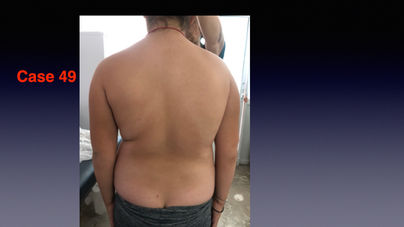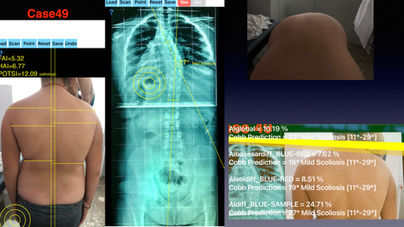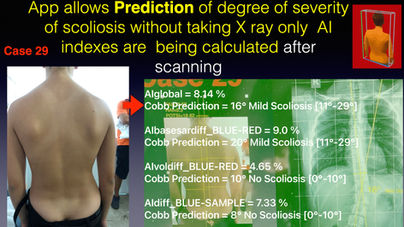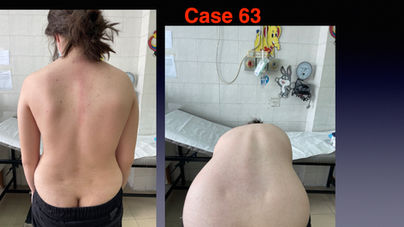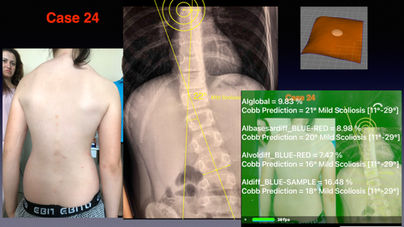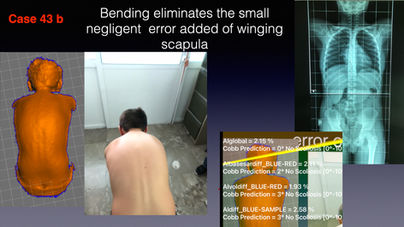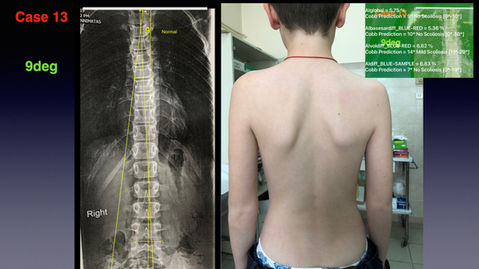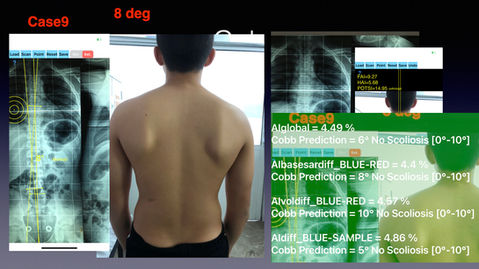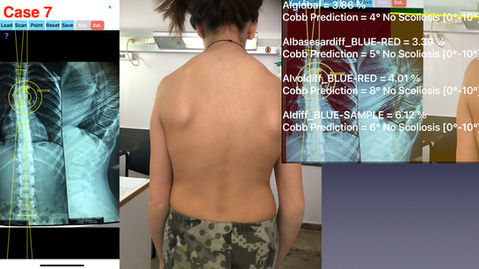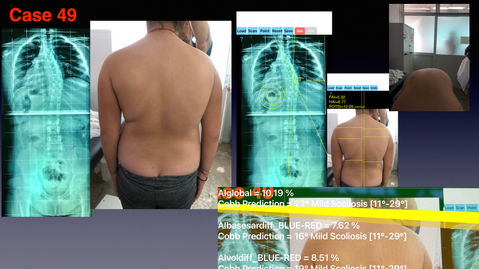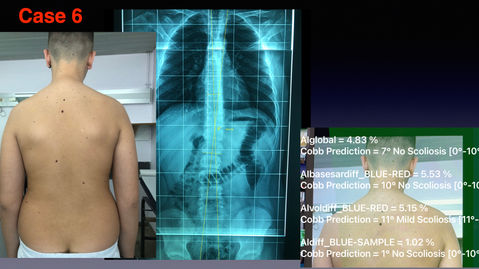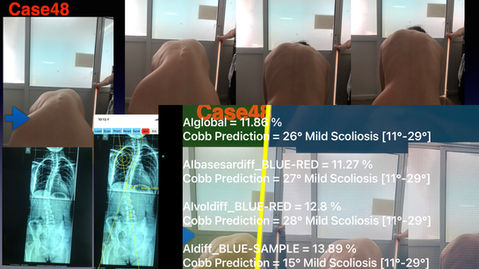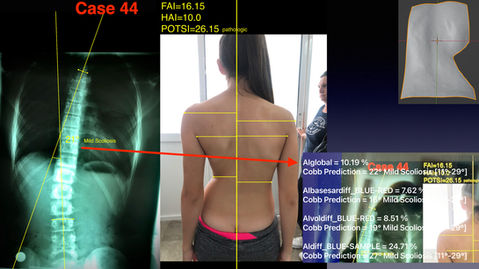Scoliosis App

Once the STL file is loaded in the App four kind of Asymmetry Indexes (AIs) (a,b,c,d) are being calculated a. weighted Average Asymmetry Index) global Asymmetry Index b. Asymmetry Index base ar diff BLUE-RED c. Asymmetry Index vol diff_BLUE-RED d. Asymmetry Index diff_BLUE-SAMPLE and printed on devices screen. The value of a. (weighted Average Asymmetry Index) or global Asymmetry Index (global AI) is calculated which is a mathematical combination of the three measured Asymmetry Indexes (b,c,



Once the STL file is loaded in the App four kind of Asymmetry Indexes (AIs) (a,b,c,d) are being calculated a. weighted Average Asymmetry Index) global Asymmetry Index b. Asymmetry Index base ar diff BLUE-RED c. Asymmetry Index vol diff_BLUE-RED d. Asymmetry Index diff_BLUE-SAMPLE and printed on devices screen. The value of a. (weighted Average Asymmetry Index) or global Asymmetry Index (global AI) is calculated which is a mathematical combination of the three measured Asymmetry Indexes (b,c,

Scoliosis App
How it works-Method-Technique
Capturing 3D back surface by third party app.
A third party app can be used like 3D Scanner app ,Heges or Scandy pro or any applications that uses Apple Lidar Sensor capture surfaces and export a STL - STL (STereoLithography) file.
A third party app can be used like 3D Scanner app
(https://apps.apple.com/gr/app/3d-scanner-app/id1419913995?l=en )
(https://3dscannerapp.com/) or
Heges (https://apps.apple.com/gr/app/heges-3d-scanner/id1382310112?l=en) or
Scandy pro https://apps.apple.com/gr/app/scandy-pro-3d-scanner-3d-app/id1388028223?l=en
or any applications that uses Apple Lidar Sensor capture surfaces and export a STL - STL (STereoLithography) file.
Technique
Patient were asked to stand naturally facing backwards with their back exposed from the neck to the pants. The clinical doctor captures with Apple’s device lidars sensor on the whole surface of the patient’s back in standing position or in full forward bending position. Back, breech, neck, occipital surfaces usually are all included in stl file.
For better results and accurate measurements with ScoliosisApp the original STL should be cleared from unnecessary elements for analysis, e.g. the floor, breech, neck, and occipital surfaces etc. only the persons back is needed, preferable to have a rectangular area of interest. Commonly in third party apps are various ways to cut and reduced unnecessary parts of back surface stl files. Before loading in app stl files can be process for these issues also in desktop computers by a respective Cad software. Usually a square bounding box allows easily to be processed from the waist line to both shoulders as it is shown in tutorial videos. Once unnecessary parts are removed a final STL file is saved in a user preferred directory in device.
C. Calculation of “Asymmetry Indexes”.
By opening ScoliosisApp and pressing the load button user loads the previously saved STL file. By default one preselected case is loaded and values are presented on screen once the new stl file is loaded the asymmetry indexes are calculated once again.
Once the STL file is loaded an Augment Reality environment (AR ) is to be seen on user’s device screen. Three perpendicular yellow lines, which represent XYZ Axis are crossing through a purple sphere - origin of Stl file- the stl file , perpendicular, allowing user to inspect visually stl file in AR. In case the measured back surface is in sound perpendicular position to axis XYZ in AR and no major skew or distortion is present, which can potentially affect accuracy of measurement (please see tutorial video) then Asymmetry Indexes (AI) calculations are taking into account. This control allows user to decide about the eligibility of stl file and is a quick and reliable filter for avoiding wrong measures. In case stl file appears faint or only a portion of it user can either change background by simply moving camera device in more dark environment or step backwards in order to see on device’s screen the whole Stl file in AR respectively. Usually no issues emerge if previously the stl file is processed as rectangular region of interest please please see tutorial video.
Once the STL file is loaded in the App four kind of Asymmetry Indexes (AIs) (a,b,c,d) are being calculated a. weighted Average Asymmetry Index) global Asymmetry Index b. Asymmetry Index base ar diff BLUE-RED c. Asymmetry Index vol diff_BLUE-RED d. Asymmetry Index diff_BLUE-SAMPLE and printed on devices screen. The value of a. (weighted Average Asymmetry Index) or global Asymmetry Index (global AI) is calculated which is a mathematical combination of the three measured Asymmetry Indexes (b,c,d) -printed below global AI on devices screen-, expressed in percentage and printed in the first row on devices screen. The global Asymmetry Index (global AI) is the main index taking into account for evaluation of back surface asymmetry (AI).
In case the shape of the back surface is perfectly symmetric with respect to median sagittal plane, then Asymmetry Index (AI) index is zero %, more surface deformity of patient back due to scoliosis curvature, more deviation from perfect symmetry greater the value of Asymmetry Index measured.
Back deformity is express in percentage of Asymmetry Index and values less than 6% are considered normal (Cobb angle of <10°) otherwise letters are highlighted in red colour - pathologic.
Typically, the scoliosis is detected by spinal radiographic examination. Health care providers measure scoliosis curves in degrees by Cobb method. Cobb angle is widely used to quantify the magnitude of spinal deformity, especially in the case of scoliosis, on plain radiographs. Scoliosis is defined as a lateral spinal curvature with a Cobb angle of >10°.The degree of severity is quantified by the Cobb angle accordingly "No Scoliosis [0°-10°],”Mild Scoliosis [11°-29°] , "Moderate Scoliosis [30°-45°] ,”Severe Scoliosis [>45°].
A strong correlation level of Asymmetry indexes and Cobb angle exist (global AI, R2=0,87) meaning that the higher the percentage of asymmetry index the higher the degree of scoliosis measured by Cobb angle in spinal X-rays. From measured Asymmetry Index AI at back surface, user can predict with considerable accuracy the real Cobb angle.
This could be highly advantageous that even before spinal X-Ray is done and real Cobb angle curvature is measured the predicted Cobb value given by App coincide or is few degrees close to real Cobb angle, something valuable in clinical setting especially when the clinical doctor suspects by back surface inspection that his patient has scoliosis but is in doubt . Usually subjectivity of examiners eye estimation leads to missed diagnosis. In order to avoid this unpleasant medico-legal situation usually spine X-rays are order usually in excess. In case no scoliosis is found parents frustration from unnecessary X-ray exposure might be evident. Patients back surface spine deformity curvature which is usually not detected visually can be quantified by Asymmetry Indexes measured by Scoliosis App without even taking X rays simply by scanning persons back.
By pressing save button all values are exported in txt format and can be inserted to numbers or xls application for archiving or scientific evaluation.
Introduction-General knowledge
Ιdiopathic scoliosis is the most ordinary deformation of the spine during child growth and may go unnoticed during its development for several years and can unpredictably worsen requiring, in some cases, surgical intervention.
Typically, the scoliosis is detected by radiographic information. Health care providers measure scoliosis curves in degrees by Cobb method.The angle is widely used to quantify the magnitude of spinal deformity, especially in the case of scoliosis, on plain radiographs. Scoliosis is defined as a lateral spinal curvature with a Cobb angle of >10°.The degree of severity is quantified by the Cobb angle accordingly .
Usually following diagnosis routine monitoring the progression of the disease is done by periodically X-ray examination until skeletal maturity is reached , as frequently as every three months typically once every six months. Due to the nature of repeated radiation, subjects are susceptible to health risks and may even lead to DNA mutation and cancer. The cumulative X-ray dose to a given patient is dependent on the average number of x ray exposure, after diagnosis spinal radiographs usually taken are 12 for females, 10 for males.

Back surface shape gives first early indication of scoliosis by asymmetry and deformities of the external surface of the trunk especially by parents or relatives usually complain to general practitioner that something is not symmetric to back surface of the child.
Early detection is is considered crucial for intervention by visual inspection of the spine, asymmetry of the back is significant enough to suspect the existence of scoliosis in such cases, to evaluate spinal deformity an X-ray is ordered.
One of the biggest problems with scoliosis is that it can get rapidly worse when a child goes through their growth spurt during puberty: the adolescent growth spurt. The problem here is that if a child has a mild scoliosis when they are young, but it won’t get drastically worse until they hit their adolescent growth spurt,
Clinical detection is not easy and is fraught with errors and usually related to doctor experience. The earlier the scoliosis is caught and treated, the better the outcome. Many cases are missed and medico-legal question to medical physician many years after initial patients visit could be arise.
Simple visual inspection of backs by experienced doctor observation provides information but is is time consuming, cumbersome, highly subjective and not accurate and experienced dependent .
Scoliometers could help evaluate the appearance of an asymmetric spine deformity with variable sensitivity and specificity but cannot substitute radiography.
Thus, there is a need to quantify scoliosis-induced asymmetry using a non-invasive method entailing the reduction of radiation exposure. The developed method can serve as a potential alternative to the existing approach and meet the requirement of non-invasiveness towards measuring asymmetry in scoliosis patients.
Surface topography is a method of trunk shape evaluation based on external body contour assessment that can be performed with several techniques which have been developed in previous decades , like Moire topography, raster- stereophotography, where computer analysis of digitized topographic information monitor curve progression, and provide information that can be used to make treatment decisions But no sufficient accuracy has be proven to be clinically useful, these system were cumbersome , expensive, not available in every day clinical setting.

Description
Idiopathic scoliosis is the most common deformation of the spine during child growth and may go unnoticed during its development for several years. Unpredictably can worsen requiring, in some cases, surgical intervention. Monitoring of the progression of the disease is done by periodically X-ray examination until skeletal maturity is reached.
The cumulative X-ray dose to a given patient is dependent on the average number of x ray exposure, after diagnosis spinal radiographs usually taken are 12 for females, 10 for males. Back surface shape gives first early indication of scoliosis by asymmetry and deformities of the external surface of the trunk especially by parents or relatives usually complaining that something is not symmetric to back surface of the child.
Technique.
Patients were asked to stand naturally facing backwards with their back exposed from the neck to the pants. The clinical doctor captures with Apple’s lidars sensor on iPhone or iPad the whole surface of the patient’s back in standing position or in bending position. Capturing 3D back surface is done with third party app ( 3D scan app or Heges app or ScandyPro or any app -this is user’s preference-) downloaded from App Store that exploits Apples LiDAR sensor and is capable of exporting STL files.
A final STL file is imported to scoliosis app and asymmetry analysis is done.
Four kinds of asymmetry Indexes (AI) are being calculated and expressed in percentage. The weighted Average Asymmetry Index or global Asymmetry Index ( AI) is the result of combination of the other three measured Indexes. In case the shape of the back surface is perfectly symmetric with respect to the median sagittal plane, then AI index is zero %, more surface deformity due to scoliosis at patient back’s shape means more deviation from perfect symmetry and greater value of AI. Back deformity is express in percentage, values over 6% are pathologic.
A strong correlation level of Asymmetry indexes and Cobb angle exist ,meaning that the higher the percentage of asymmetry index the higher the degree of scoliosis measured by Cobb angle in spinal X-rays. App works in reverse meaning that from the measured AI at back surface can predict with considerable accuracy the real Cobb angle before spinal X-Ray.
App might be a tool to identify early patients having scoliosis but the diagnosis has been missed due to subtle or even unnoticeable clinical signs by naked eye, feature particularly useful in clinical settings where quick results without losing time are needed, allowing to quantify the spine deformity by simply taking advantage of apples device’s lidars sensor.
Especially for primary care physician is of great importance that could simply scanning childs back and have a meaningful indication that something is wrong without the need of costly expertise evaluation.
The app might also help to
-establish diagnosis objectively by back surface topography by calculating only asymmetry index.
-indicate easily by a pathologic value of Asymmetry Index which patient should be referred thus reducing the missed cases.
-quantify the spine deformity objectively for cosmetic results.
-quick monitor objectively the progression and the severity of scoliosis avoiding unnecessary X-ray exposure especially at younger age, helping treatment decision.
-avoid buying cumbersome extra devices, only Apple’s devices with lidars sensor is needed.
-establish a massive reliable screening test of Scoliosis to paediatric population.
The app seem to be a tool to identify easily and earlier patients having scoliosis but the diagnosis might be missed due to subtle or unnoticeable clinical signs at patient back during clinical evaluation.
Patients back surface spine deformity curvature which is usually not detected even visually can be quantified by Asymmetry Indexes measured by Scoliosis App.Please see relevant video tutorials


The clinical doctor captures with Apple’s device lidars sensor on the whole surface of the patient’s back in standing position or in full forward bending position.
Captured patients back, file stl is processed cleared from unnecessary elements for analysis, e.g. the floor, breech, neck, and occipital surfaces etc. only the persons back is needed, preferable to have a rectangular area of interest.
Scanning and processing has done in this video with 3D Scanner app (https://apps.apple.com/gr/app/3d-scanner-app/id1419913995?l=en )(https://3dscannerapp.com/)
Reference
1.Daruwalla, J. S. et all A., Aggouris, C. & Drakoutos, E. A review of the trunk surface metrics used as scoliosis and other deformities evaluation indices. Scoliosis 5, 12 (2010).
2. Ueno, M. et al. A 5-year epidemiological study on the prevalence rate of idiopathic scoliosis in Tokyo: School screening of more than 250,000 children. J Orthop Sci 16, 1–6 (2011).
3. Chowanska, J.et all Z. School screening for scoliosis: Can surface topography replace
examination with scoliometer? Scoliosis 7, 9 (2012)
4. Shannon TM: Development of an apparatus to evaluate adolescent idiopathic scoliosis by dynamic surface topography, Stud Health Technol Inform 140:121, 2008.
5. Rogala EJ, Drummond DS, Gurr J: Scoliosis: incidence and natural history. A prospective epidemiological study, J Bone Joint Surg Am 60:173, 1978.
6. Levy, A. et al. Reducing the lifetime risk of cancer from spinal radiographs among people with adolescent idiopathic scoliosis. Spine, 21(13), 1996, p.1540–1548.
7. Hines, T. et al. School scoliosis screenings: Family experiences and potential anxiety after orthopaedic referral. Spine (Phila Pa 1976) 40, E1135–1143 (2015)
8. Hresko, M. T. et al. Early detection of idiopathic scoliosis in adolescents. J Bone Joint Surg Am 98, e67 (2016)
9.Labelle, H. et al. Screening for adolescent idiopathic scoliosis: An information statement by the Scoliosis Research Society International Task Force. Scoliosis 8, 17 (2013)
11. Fong, D. Y. et al. A meta-analysis of the clinical effectiveness of school scoliosis screening. Spine (Phila Pa 1976) 35, 1061–1071 (2010).
Disclaimer
Regarding its plausibility no diagnosis is given. App might provide an early indication that further evaluation may be warranted by Speciality Doctor. Algorithm in App detects in surface Irregularity between left and right site of the back. Explicitly is announced that the app is for scientific reasons available and not for diagnosis or treatment. Clinical judgment and experience are required to properly use the software. App alone do not replace an M.D. All information received from the App output must be reviewed before any treatment. Medical experience are required to properly use the App. The software is not for primary image interpretation. Any influence to the operators in making decisions remains Surgeons own responsibility and experience. App does not dispense medical advice. Patient should seek a doctor’s advice in addition to using this app and or before making any medical decisions for themself. App does not claim that measures scoliosis it measure back asymmetry and gives a value that might be helpful. Although prediction might be made still is investigational and not proven by scientific papers, these are pending. Never substitute or replace doctors advice or change treatment modalities based on any measured Asymmetry Index. App indicated for assisting healthcare professionals for scientific reasons. Clinical judgment and experience are required to properly use app and further research is pending.

